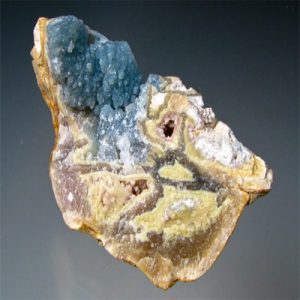Wardite: Gemstones Information
Wardite is a mineral that belongs to the phosphate mineral group and is composed of hydrated sodium calcium aluminum phosphate. It was first discovered in 1896 in Ward County, Texas, USA, hence the name “wardite.” This mineral typically forms in phosphate-rich environments, such as phosphate-rich pegmatites, hydrothermal veins, and sedimentary deposits.
Let’s delve into the information and potential benefits associated with wardite:
Chemical Composition: The chemical formula of wardite is NaAl3(PO4)2(OH)4•2H2O. It contains sodium (Na), aluminum (Al), phosphate (PO4), hydroxide (OH), and water molecules (H2O). Wardite often occurs as fine-grained to earthy masses or as prismatic crystals, commonly exhibiting colors ranging from colorless to white, pale yellow, green, or blue.
Occurrence: Wardite is commonly found in association with other phosphate minerals, including variscite, turquoise, and wavellite, as well as with secondary alteration minerals such as limonite and kaolinite. Significant deposits of wardite have been discovered in various locations worldwide, including the United States, Brazil, Germany, Australia, and Portugal.
Mineralogical Significance: Wardite is valued by mineralogists and geologists for its role in understanding phosphate mineralization processes and the geological history of phosphate-rich environments. Studying wardite-bearing rocks provides insights into the conditions under which these minerals form, including temperature, pressure, and chemical composition. Additionally, wardite’s occurrence in specific geological settings may indicate the presence of valuable phosphate deposits.
Collectibility and Market Value: Wardite specimens are highly prized by mineral collectors and enthusiasts for their unique crystal forms, vibrant colors, and aesthetic appeal. Fine-quality wardite crystals, particularly those with intense coloration and well-defined crystal habits, command premium prices in the mineral market. Collectors often seek out wardite specimens from classic localities or those exhibiting rare crystal forms or color variations.
Metaphysical Properties: In metaphysical and holistic healing practices, wardite is believed to possess various beneficial properties. It is thought to promote feelings of calmness, balance, and emotional stability, making it a popular choice for meditation and spiritual practices. Wardite is also believed to enhance intuition, creativity, and spiritual growth, supporting individuals on their journey of self-discovery and personal development.
Artistic and Decorative Use: Wardite’s attractive colors and unique crystal forms make it a popular choice for lapidary work and artistic creations. It can be cut and polished into gemstones or cabochons for use in jewelry, decorative objects, and ornamental pieces. Wardite specimens may also be used as display pieces in mineral collections, museum exhibits, and educational settings, showcasing their natural beauty and geological significance.
Educational Significance: Wardite’s presence in phosphate-rich environments provides valuable educational opportunities for students and researchers interested in mineralogy, geology, and earth sciences. Studying wardite specimens helps enhance our understanding of mineral formation processes, geological environments, and the interconnectedness of Earth’s systems. Wardite-bearing rocks may serve as teaching tools for illustrating concepts related to mineral identification, crystallography, and geological mapping.
In summary, wardite is a fascinating mineral with unique properties and potential benefits. Whether appreciated for its geological significance, collectibility, metaphysical properties, or artistic appeal, wardite continues to captivate individuals around the world with its beauty, rarity, and versatility.





